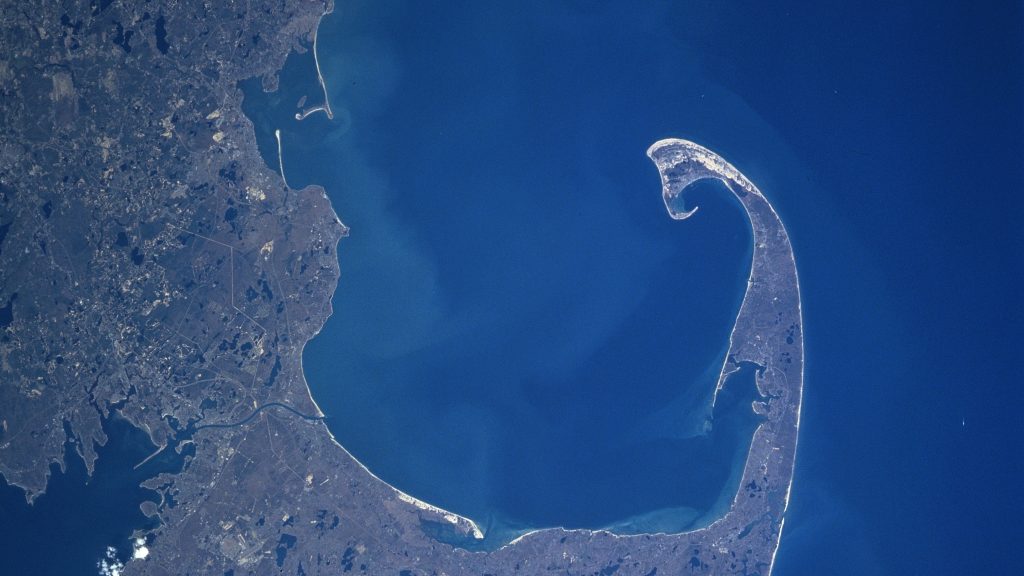WHOI Sea Grant to Map Potential Path of Proposed Wastewater Release from Pilgrim Nuclear Power Station

A team of researchers from WHOI will undertake the study, which will provide essential information about where Cape Cod Bay surface waters travel, how long the water resides in the bay, and the seasonal and other drivers that affect that movement. The team includes scientists and researchers from the WHOI Physical Oceanography and Marine Chemistry Departments. The one-year project will begin in July 2023.
“The proposed release of radioactive wastewater into Cape Cod Bay concerns local residents, tourists, commercial and recreational fishermen, and the aquaculture sector alike,” said Matt Charette, WHOI Sea Grant director and a senior scientist in WHOI’s Marine Chemistry Department. “Currently, one cannot predict the path the wastewater would take through the Bay, including major shellfish growing areas, because we still lack a basic understanding of water transport pathways there. This study will provide essential information to regulators as they consider any related permit requests, or any future events that might occur, such as oil spills or harmful algal blooms.”
Cape Cod Bay hosts a diverse marine ecosystem and is the site of commercial and recreational fishing and aquaculture enterprises, which all depend critically on the ecology and water quality in the Bay. While it is unknown how a release of radioactive pollutants would impact the ecology of the Bay or the safety of the seafood supply, there is the strong potential for economic and reputational damage if consumers are reluctant to buy seafood harvested from the region.
”Our research will provide a scientific foundation for a more informed decision on the fate of the wastewater plume from the Pilgrim Nuclear Power Station, especially in relation to the local communities and businesses that might be affected,” said Irina Rypina, a physical oceanographer at WHOI and the lead scientist on the project.
The scientists will use a NOAA state-of-the-art, realistic, high-resolution ocean circulation model that has been validated against data from drifting buoys in Cape Cod Bay. The research will focus on the near-surface transport, how that varies seasonally, and the role of wind as a driving force of circulation in and around the Bay.
This study, alone, will not be able to draw conclusions about the impacts of a release of radioactive wastewater on the health and safety of humans and animals in Cape Cod Bay and surrounding waters or its effects on recreational and commercial fishing, shellfishing and aquaculture because the amounts and types of radionuclides in the wastewater from Pilgrim Nuclear Power Station are not yet known. However, the study will provide a better understanding of transport and spreading pathways, and the associated time scales.
“We don’t know what’s in the wastewater yet and so can’t predict the fate of radionuclides, but this study addresses the first fundamental question: Where does the water go and how quickly does it move,” said Ken Buesseler, a WHOI marine chemist who has studied the fate of radioactivity in the ocean, including material released from the Fukushima Dai-ichi nuclear power plant in 2011. “It would be important to do follow up research on the fate of the different radionuclides present in the waters. Some radioactive contaminants will move largely with ocean currents, but others are more inclined to end up accumulating with seafloor sediments, which is a concern especially with bottom-dwelling and filter-feeding organisms.”
The scientists note that even if the release of radioactive wastewater into Cape Cod Bay is ultimately not permitted, the study provides a better understanding of transport pathways and processes in and around Cape Cod Bay and the underlying drivers. This understanding would be beneficial for situations involving search and rescue, oil spill response, harmful algal blooms, marine microplastic pollution, movement of drifting larval marine biota, among others.
“I am pleased that the Woods Hole Oceanographic Institution is commissioning an initial study to help communities along Cape Cod Bay better understand the potential impacts of a discharge of radioactive water from the Pilgrim Nuclear Power Station. This is an important first step,” said Senator Ed Markey. “I secured a commitment from Holtec to support an independent study of how the wastewater would interact with Cape Cod Bay, and I have called on them to uphold that commitment to the community, which is rightfully concerned about the potential economic and ecological impacts.”
“I am very grateful to WHOI Sea Grant for stepping up to take on the research required to help better understand the impact that the decommissioning of the Pilgrim Nuclear Power Station will have on both the ecosystem and the blue economy in and around Cape Cod Bay,” said Congressman Bill Keating. “Decisions surrounding the decommissioning of PNPS must be based on scientific fact.”
###
Press Contact: Stephanie Murphy, samurphy@whoi.edu
About WHOI Sea Grant
WHOI Sea Grant supports research, education, and extension projects that encourage environmental stewardship, long-term economic development, and responsible use of the nation’s coastal and ocean resources. It is part of the National Sea Grant College Program of the National Oceanic and Atmospheric Administration, a network of 34 individual programs located in each of the coastal and Great Lakes states. Together, these programs form a national network of over 300 participating institutions involving more than 3,000 scientists, engineers, educators, students, and outreach experts.
